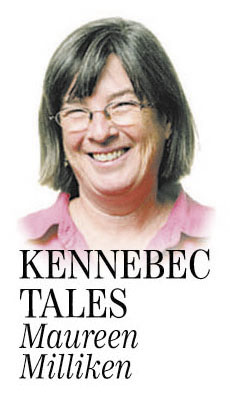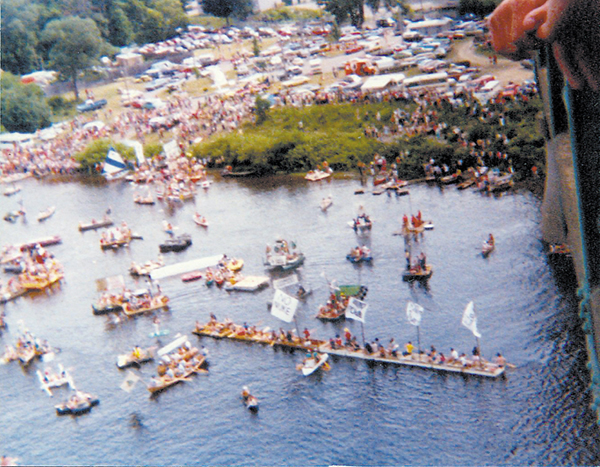There’s been some crazy traffic up and down the Kennebec River’s 170 miles over the centuries.
It was used by native people as a trade route for thousands of years before the Europeans came on the scene in the early 1600s. By then, it was a major Abenaki highway and they named it Kennebec, which means “large still water” or “long quiet water,” depending on who you ask.
About 250 years ago, Benedict Arnold and his 1,100 men came up the river and spent a lot of time in the area before taking their bateaux to Quebec City. Considering what happened up there, their time in Augusta may have been the last real fun they had.
By the early 1800s, the river had been taken over by the logging companies and the mills, and every summer for nearly two centuries, its main traffic was hundreds of thousands of cords of timber that drifted from Moosehead Lake to the mills that lined its banks. Just like Arnold, the river drivers used bateaux.
The last log drive on the Kennebec was in 1976, from Moosehead to the Scott paper mill in Winslow, but the last logs to come through Augusta were in 1973.
The Indians, Arnold and his crew and the loggers all left an indelible impression on the Augusta area that endures today.
And then there was the Whatever Race.
Besides building Maine and leaving behind a rich history, the log drives and mills, coupled with the towns and cities they helped build along the way, also left behind a lot of garbage and a nearly dead river.
“The highly polluted Kennebec River became useless for all public and commercial use other than as a treatment system for pulpwood, a conduit for wastewater discharge, and hydro-power,” wrote Daniel Michor in 2001. “A river that was once of significant natural and cultural value to the people had become a blemish and embarrassment to the community and the state.”
In other words, by the 1960s, the river was an open sewer.
Anyone who lived in the Augusta area in the 1960s and early 1970s will remember the dirty and sometimes neon-tinged foam that rode atop the brown water and lined the riverbanks. No one will remember seeing fish or much wildlife — there weren’t any. Mostly just the foam.
Luckily for us 40 or 50 years later, “the prevailing sentiment in the 1960s was that waste disposal was no longer a legitimate use for the stream,” Michor wrote in “People in Nature: Environmental History of the Kennebec River.”
A huge effort by residents up and down the river and by Sen. Edmund Muskie, the force behind the Clean Water Act of 1972, was the beginning of the end of that foamy, turgid Kennebec.
What does this have to do with the Whatever Race?
A group of Augusta residents sitting around one New Year’s Eve in the mid-1970s came up with the idea of the race as a way of celebrating the newly clean Kennebec. This brainstorm is commemorated on a plaque at the East Side Boat Landing.
Before “whatever” became the ubiquitous “leave me alone I don’t care” of today, in central Maine it meant “Let’s go down the river in an old Volkswagen on oil drums or on a bateau wearing an Edmund Muskie mask.”
The idea behind the “race” was that anything could be used on the six-mile route from Augusta to Gardiner, as long as it was not powered by a motor.
Clean and green as we say in the 21st century.
Those early Whatever Races were also wild and crazy, as we used to say in the ’70s.
The river, once clogged with logs and dirty foam, was now clogged with anything that would float — people in costume, politically themed rafts, families with canoes tied together.
Whatever.
And yes, kids, it was the 1970s, so alcohol was involved.
The official take on why it ended in the mid-90s is diplomatic.
“It was time for a change,” said Peter Thompson, president of the Kennebec Valley Chamber of Commerce, this week.
He said city leaders wanted something that was more for families and children. “It was a great spectator event and great for those who participated,” Thompson said. But it was also “a danger.”
As noted before, alcohol was involved.
In 1996 and 1997, the race morphed into an attempt to break the Guinness World Record for most kayaks and canoes linked together at once. Thompson remembers the record as something like 600.
The event drew 442 kayaks and canoes the first year and was even filmed by the BBC.
The second year “we got I think about 443,” Thompson said with a laugh.
So the crew from the year before and maybe one guy who saw it on TV?
“No, I think maybe one guy from the year before and 442 new ones,” he said.
Now we have the Greater Kennebec River Whatever Family Festival, which culminates today with daylong events at Fort Western, an evening party across the river, the parade and fireworks.
Not a bad lineup.
The old Whatever Race wasn’t on the Fourth of July. It was a 1970s thing, so it was loosely organized, no-frills and everyone let their freak flag fly. People in the 1970s-era short shorts packed safety-fenceless Memorial Bridge. The people below honked horns, waved their flags and eased on down the newly clean river. And, did I mention? Alcohol was involved.
Lots of fun. There are probably a lot of good reasons we don’t do that anymore.
But come to think of it, wouldn’t it be nice if there was a beer tent?
Maureen Milliken is news editor of the Kennebec Journal and Morning Sentinel. Email her at mmilliken@mainetoday.com. Kennebec Tales runs the first and third Thursday of the month.
Send questions/comments to the editors.




Success. Please wait for the page to reload. If the page does not reload within 5 seconds, please refresh the page.
Enter your email and password to access comments.
Hi, to comment on stories you must . This profile is in addition to your subscription and website login.
Already have a commenting profile? .
Invalid username/password.
Please check your email to confirm and complete your registration.
Only subscribers are eligible to post comments. Please subscribe or login first for digital access. Here’s why.
Use the form below to reset your password. When you've submitted your account email, we will send an email with a reset code.